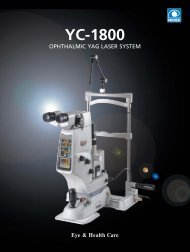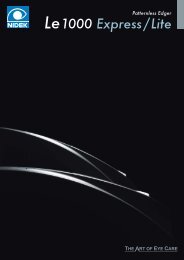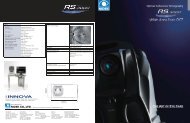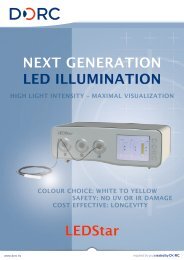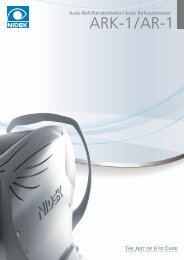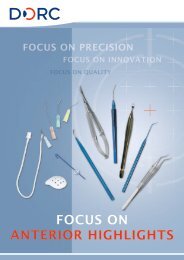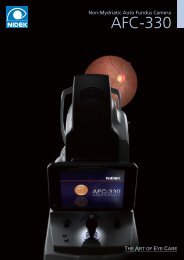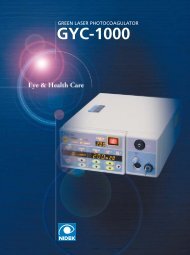Reichert Ocular Response Analyzer Measures Corneal ... - innova
Reichert Ocular Response Analyzer Measures Corneal ... - innova
Reichert Ocular Response Analyzer Measures Corneal ... - innova
- No tags were found...
You also want an ePaper? Increase the reach of your titles
YUMPU automatically turns print PDFs into web optimized ePapers that Google loves.
How it works:Operation of the <strong>Ocular</strong> <strong>Response</strong> <strong>Analyzer</strong>The <strong>Ocular</strong> <strong>Response</strong> <strong>Analyzer</strong> utilizes a rapid airimpulse to apply force to the cornea, and an advancedelectro-optical system to monitor its deformation.Alignment to the patient’s eye is fully automated.A precisely-metered collimated-air-pulse causes thecornea to move inwards, past applanation, and into aslight concavity. Milliseconds after applanation, the airpump shuts off and the pressure declines in a smoothfashion. As the pressure decreases, the cornea begins toreturn to its normal configuration.Background on <strong>Corneal</strong> Hysteresis:What are we really measuring?It was observed that CH measurements were repeatableon individual eyes but differed significantly from personto person. The distribution of CH values for a normalpopulation (N=246 eyes) is shown below in Figure 2.It was also observed that these subject’s right and lefteye CH values are strongly correlated (R 2 0.60) furtherdemonstrating that corneal hysteresis is a biologicalmetric.In the process, it once again passes through anapplanated state. The applanation detection systemmonitors the cornea throughout the entire process, andtwo independent pressure values are derived from theINWARD and OUTWARD applanation events.One might expect these two pressure values to be thesame. However, due to the dynamic nature of the airpulse, the viscous damping in the cornea causes delaysin the inward and outward applanation events, resultingin two different pressure values.The average of these two pressure values provides arepeatable, Goldmann-correlated IOP value (IOPG).The difference between these two pressure values is<strong>Corneal</strong> Hysteresis (CH). (See Figure 1). The abilityto measure this effect is the key to the understandingthe biomechanical properties of the cornea and theirinfluence on the IOP measurement process.Figure 2 – Typical CH distribution of a normal populationIn order to explain CH, attempts were made to correlateit with corneal radius, astigmatism, visual acuity, andaxial length. No correlations of notable significancewere discovered, causing the investigators to believethat they were indeed measuring a new ocular parameter.Perhaps the most obvious relationship to examine is thatof the new CH measurement vs. traditional GoldmannIOP values.<strong>Corneal</strong> Hysteresis and Intraocular PressureTo investigate the relationship between CH and IOP,thirty-two normal eyes were measured at 3 differentpressure levels using both a Goldmann tonometerand the <strong>Ocular</strong> <strong>Response</strong> <strong>Analyzer</strong> (see Figure 3).Measurements were made within minutes of each otherto minimize diurnal effects.Figure 1 - The difference between the “inward” applanation and the“outward” applanation is called <strong>Corneal</strong> HysteresisInitial IOP measurements were made on the eyes in theirnormal state and then at two artificially elevated pressurelevels induced by a modified ophthalmodynamometer.The resulting inward and outward applanation datafor each set of measurements were plotted againstGoldmann IOP.



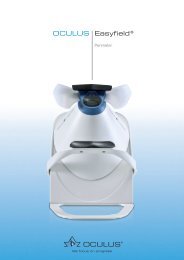
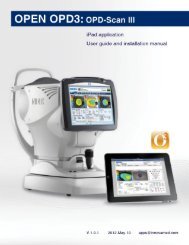
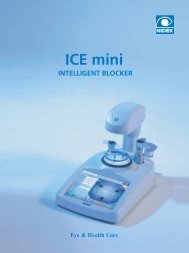
![OCT Setting: CORNEA RADIAL 6( 6.0mm[1024] ) - innova](https://img.yumpu.com/48127738/1/190x146/oct-setting-cornea-radial-6-60mm1024-innova.jpg?quality=85)
